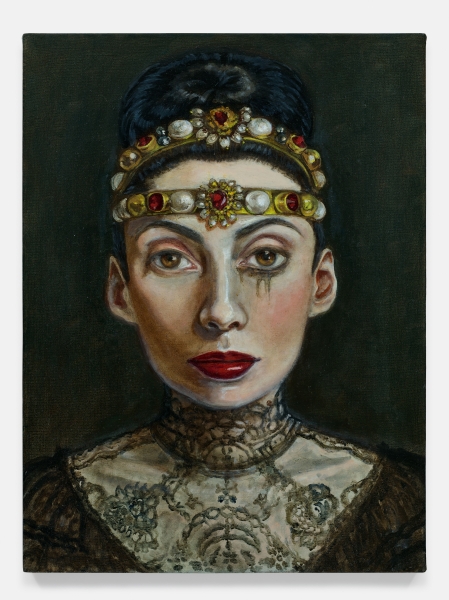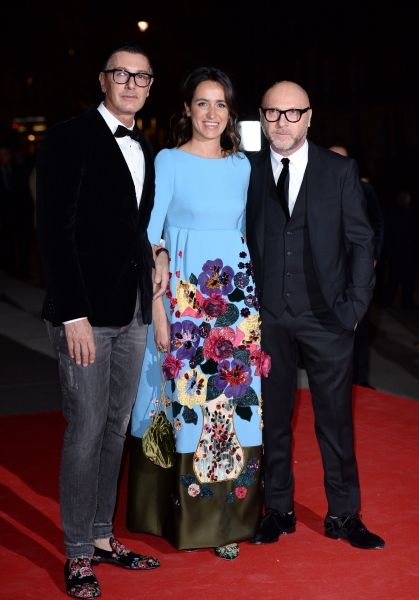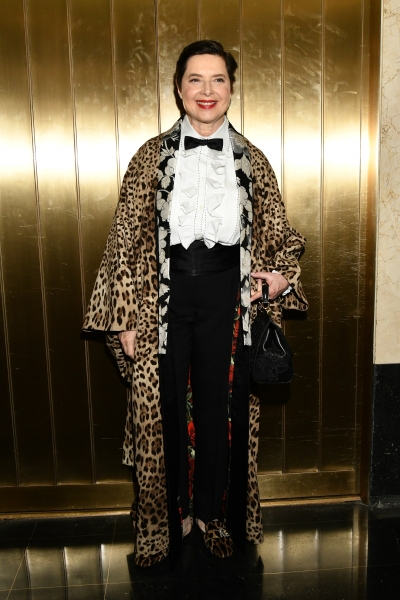
Dolce and Gabbana’s exhibition, From The Heart to The Hands—opening April 7th at Milan’s Palazzo Reale—is a celebration of every aspect of Italian culture that is handmade, not just fashion: Everything from food to art will be celebrated—as will how it all has inspired Domenico Dolce and Stefano Gabbana over the last four decades of their label. (Yep, they’ll be reaching that milestone in their careers in 2024, too—big year!) Ahead of the opening, we spoke with three women—designer Coco Brandoloni d’Adda, artist Anh Duong, and actor and model Isabella Rossellini—about how they’ve worked with, and themselves been inspired by, Dolce and Gabbana over the years. (One thing these women all have in common, as it turns out: Who hasn’t loved looking like a black-clad Sicilian widow at some point in her life?!)
Coco Brandolini d’Adda, Designer, d’Adda
Domenico, Stefano, and I met about twelve years ago while I was working with Tomas Maier at Bottega Veneta—it was at one of those super-fun parties Dolce and Gabbana used to do after their shows; my sister Bianca introduced us. As I was chatting to Domenico, it was—this is the only experience I have ever had like this in my work life—it was almost like a seduction! He was so full of questions, and after about three minutes he mentioned that he and Stefano were launching Alta Moda. People kept coming up to him and saying, ‘Domenico, you have to see Suzy Menkes’; ‘Come, you have to see’ this person, or that person… but he just kept speaking with me. Domenico is a lion—he never gets deterred—and for us, it was really like love at first sight. Later, I went to show Domenico what I’d been doing, and he looked at everything, very—very—fast, and then he asked me: “So, when will you start?”
By this point I hadn’t even really met Stefano properly, and Domenico said, jokingly, "If you don’t get along, it would be a problem.” Stefano and I did meet, quite by chance, when we were both flying to Paris for Franca Sozzani’s Légion d’Honneur ceremony, and it was all great. A few days later, Domenico told me, “It’s rare for someone to get on with both of us so well. Welcome to Dolce and Gabbana.”

I had a desk in the Alta Moda studio and was working with their first assistant, Antonio, on design, research, embroideries…. It was the best experience: Anything and everything was possible. If we wanted to do embroidery with white shells, or special flowers, we did—and they would be used for the most beautiful dresses. Creatively, it was incredible. Alta Moda felt like their baby, really—something that they had waited a long time to do, because with couture, it’s a question of maturity. We would have these design meetings, and the energy was the most amazing phenomenon I’ve observed in my work life—the sheer flow of ideas. After a while, I also took on a kind of ambassador role, because they liked how I wore the Alta Moda. I got to travel, I got to go to the Met Gala. It was a lot of fun.
Italy is the basis of everything they do. With the ready to wear, there is a lot of inspiration from Sicily—of women wearing black, of going to a funeral. Those references come from Domenico’s childhood, because he’s the Sicilian one. Stefano is from Milan, so it’s more northern Italian, a whole other aesthetic. They always draw on their two origins, and then they meet somewhere in the middle. With Alta Moda, Domenico would say, "I am going to do our shows all over Italy—I want people to see my country,” and I think that has been key to its success. It’s not just Milan or Rome or Venice; they’ve chosen to show in Capri, Portofino, Naples—and Naples is not like Venice—it’s raw. I remember so many people were like, “You’re mad to do a show in Naples—it’s so dangerous; you’ll need so much security. You can’t have clients arriving in all their jewelry.”
Then Domenico chose to show in literally the most dangerous neighborhood in the city—because it’s also the most beautiful! [Laughs] But Domenico and Stefano, when they were working on the show, would speak with people who lived locally—involving them, asking for their help. It was their way of showing respect, of saying ‘Thank you for having us.’ I think the people who lived there understood their passion, because what Italy responds to, more than any other country, is emotion—and nostalgia, because Stefano and Domenico had brought that too. Nothing bad happened—not a single shoe or earring went missing.
After their very first Alta Moda show, which was in Taormina, Domenico burst into tears: The emotion of doing it had been so strong. You could see the release of the pressure, and the fear, and the passion behind it all: All of that came out with the tears. Stefano was holding him as he was crying, because Stefano always knows. Their dynamic is really interesting. The few times I saw them not get on, they were more like an old married couple: If they have a disagreement, they can sort it out with just a look, without saying anything. They would just sit back down and start working together again—Stefano would draw something, Domenico would add something, and then boom—the look was done! I’ve rarely seen two people know each other better. Even before Domenico thinks about crying, Stefano already knows that he’s going to do it. It’s really very sweet.
Anh Duong, Artist
My relationship with Domenico and Stefano started when I was a model. I had gone [from Paris] to Milan for my first season of shows, and I met them then—I think they were about to do their first-ever show. One of the things that makes me think that is they didn’t have any money to pay models, so they offered all of us clothes instead! Of course I said yes, because they were the young, cool designers who were very endearing and charming and fun—and who also had so much enthusiasm.
Even at that point, they already had the DNA of their company: the Sicilian woman, wearing something black and tight, was really cool—you felt like, Wow: Even though I am young, I want to look just like that! Backstage, we were all dressed like Sicilian women [laughs]—it reminded me of the great period of Italian Neorealist cinema I grew up watching—films by Visconti, Rossellini: It was a whole world of fantasy. Domenico and Stefano loved them, too—Sophia Loren is one of their icons, for sure. Their style, that way of dressing, was [to take something] very feminine and modernize it and make it very appealing, and sexy, and timeless.
My relationship with them got stronger after I stopped modeling and became an artist—I was 26 and felt like I was too old already, and yet here I am, thirty years later, still sometimes working as a model! [Laughs] My idea was to bring art and fashion together, because they’d always been very separate, but for me the relationship was authentic and natural. You can look at a Velazquez and see a king wearing his robes—what’s worn is so important in portraiture. The clothes help the narrative, they tell the story, and the clothes are a great medium for brushstrokes, colors, and combinations of shapes. When I started to do my self-portraiture, it was obvious to me I would work with all my designer friends—with Christian [Lacroix], with Stefano and Domenico—because there was so much richness in their fashion.
Domenico was really interested in what I was doing—he’d always been a big art lover—and then he and Stefano started collecting my work. I had painted Domenico’s portrait—he was wearing a black suit, white shirt, gold chain, and sneakers, so pretty much his everyday uniform—at a loft I used to have on 12th Street in the West Village. He was getting really tired while I worked, but he was so strong that he kept going. I’ve noticed that the people who are the most busy, the most creative, who are real do-ers—they always have the most stamina. So we did his portrait, which is 8 feet by 6, and I believe it’s at his home in Milan, in his dressing room, so he can see himself every morning.

When Stefano and Domenico started the Alta Moda, they invited me along. I had done a lot of couture shows—for Saint Laurent, and for Lacroix; Domenico loved Lacroix—and I think they just wanted to have me around. Their couture is so distinctive because they have made it into a kind of joyful world [in which] their clients can experience Italy. When they did the show in Capri, for instance, you arrived via these tiny adorable paints that landed on the beach—or in Palermo, they showed the couture over five days in the palazzo where Visconti filmed The Leopard. They want to give their clients more than a dress or a coat; they want to share their love of their country and to celebrate its craftsmanship—like the show in Puglia, where they incorporated the local basket-weaving traditions into the clothes. I’ve seen quite a few designers struggle with couture, but for them it has paid off because it always comes from the heart.
I had used some of their clothes in the work I was showing at an exhibition in London, and they had bought some of those paintings. Then, after the first Alta Moda show, they mentioned that maybe I could paint something from it—whatever I felt inspired by. It was all very organic—from the love of art that Domenico has, and the love of fashion that I have. The beauty of it was that I was given total carte blanche to do whatever I wanted. I selected dresses from the show, and they shipped them to my studio in New York. I’d either put the dress on a mannequin, or I would put them on myself—which always made me nervous, because I use oil paint, and it would be impossible to get it off!
By that time, I had a new studio in the Village—the parlor floor of a house where Mark Twain once lived. Domenico visited, and I showed him the work, and he got really excited: “Do more,” he said—”bigger, more, bigger, more, more, more!” The wonderful thing about them both is their enthusiasm: The sky’s the limit, and I was free to fly.
So much these days is like Instagram: Everything is about instant, immediate gratification. I have 24 paintings which I have been holding on to for such a long time, and it has been a wonderful experience to live with them, grow with them. They will be in their exhibition in Milan, in the first room you enter. All of the work will be in gold frames—it’s a very Italian Renaissance type of thing—and there will be some Alta Moda clothes in the middle of the room, to emphasize that relationship between art and fashion: how one inspires the other, and also the idea that the show is about the beauty of making things by hand, fatto a mano. I’m so proud to have my work in the show. It’s a beautiful story that started with me meeting them, being inspired by them, and in turn them being inspired by me. None of us knew where it would all end up.
Isabella Rossellini, Actress and Model
I met Stefano and Domenico when I was a model—I think it was for their second advertising campaign, which was this series of beautiful photographs by Steven Meisel. I had heard of these wonderful designers, and I had seen a few of the clothes that they’d done, and it was very clear to me that their inspiration was Italy—but it was the Italy that we Italians were ashamed of [laughs]: The widows, the women dressed in the black, the perceptions of Sicilian culture. And when I saw their fashion, of course there was a lot of irony, but also they glamorized what we didn’t see as glamorous. (Quite the opposite, in fact.) It was important, then, that when we shot those pictures that there was a strong sense of what we call Italianata—the Italian DNA.

So I posed for Steven with a lot of Italian gestuality, and to do that, we’d looked at images from the films of my father [director Roberto Rossellini] and all the great actresses of that era, like Anna Magnani. That campaign was one of the most beautiful that I ever did in my career. And we have stayed friends since. I’ve always thought their work was extraordinary. I mean, there’s a lot of people who design beautiful clothes, but there is a dimension to theirs that tells a story—a story of our past—and always with great irony, and a sense of humor.
Their Italianness redeemed us. When I was growing up, it was my mother, who was Swedish and American, who I wanted to emulate: I wanted to wear hot pants, and trousers, and I wasn’t going to look like a Sicilian widow! That was the last thing I wanted. And then I found myself in my thirties wearing Dolce and Gabbana and looking exactly like that! They told a story, with a twist, that drew me in.
They've been able to tell the same story in so many different ways. These days, I tend to wear men’s clothes because they are more comfortable, and also I have a bad back—flat shoes are easier than heels! But I’ve often worn their men’s line—there was one suit that I had, very much a mafia suit, three pieces, in pinstriped gray wool, but when I took off the jacket, you could see the back of the vest was covered with all of this exquisite embroidery. With one little touch, they made the whole idea of macho tailoring funny. I loved that suit, because it was elegant and glamorous, but it also told a story.
We have a saying in Italy: The clothes don’t make the monk. And [director] Vittorio de Sica changed it, and said, The clothes do make the monk. Domenico and Stefano really are like Vittorio de Sica: You see exactly what their clothes are saying.
I have to tell you something incredible: Domenico was born in a little village in the mountains inland of Palermo, called Polizzi Generosa. And that’s where Martin Scorcese’s ancestors came from. When I was married to Marty, we went to visit Polizzi, and it was a really small town, miniscule, lost in the mountains, and I can’t believe that these two great geniuses—one of film, one of fashion—came from there. I would imagine that for Domenico, the dream started there—probably from seeing magazines, or watching television. It was a little more distant, far away, than for Stefano, who’s from Milan. They became a couple, and the blend of them is where the irony comes from—what makes them laugh, that clash of cultures—but somebody once said [laughing] that they are one designer with two heads.
When they came to show their haute couture in New York in, I think, 2018, I texted Domenico: “Domenico, did you ever imagine that you would become so famous and so big?” And he said, “Never. My mother had a little shop in Polizzi Generosa and I was hoping to have one in Milano.” He and Stefano went a little bit further than that.

